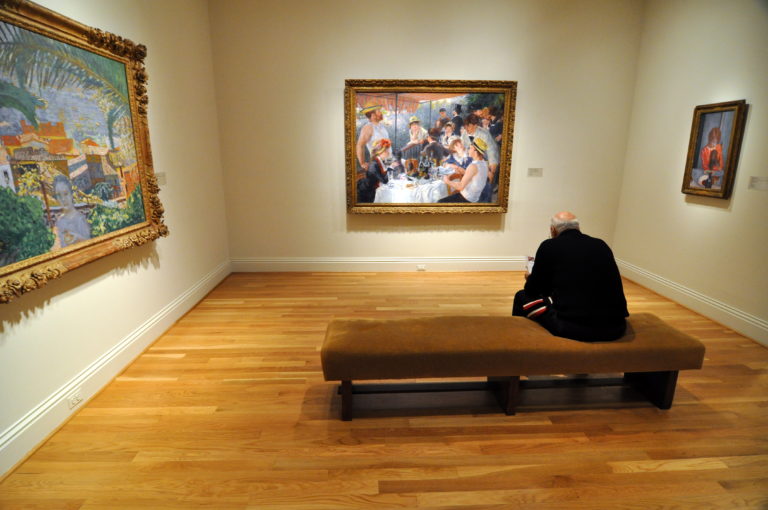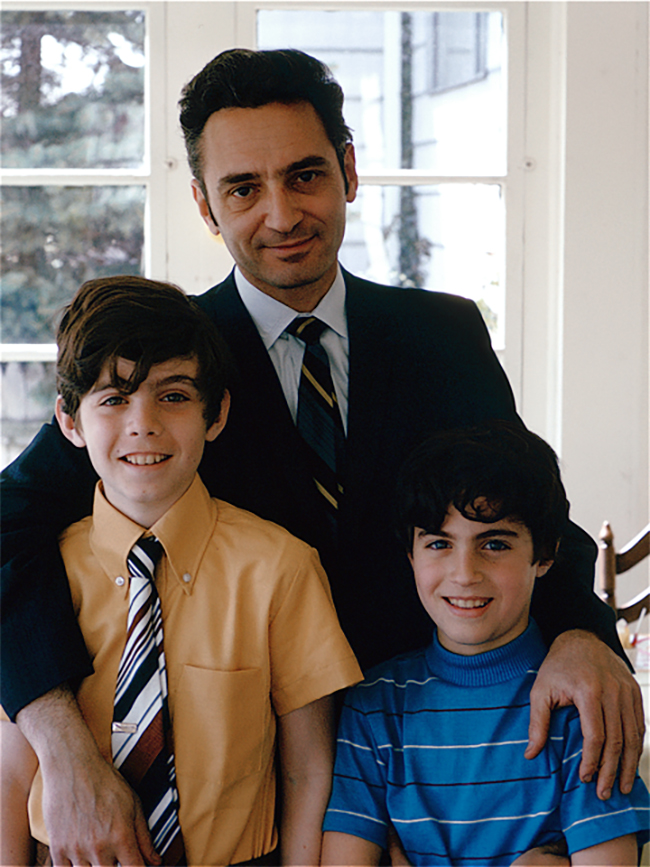
Image by Kevin Harber.
My Life with the Boating Party
A young woman speaks lovingly to a puppy while the man behind her stares into space. Everyone else is laughing and having a grand old time. Luncheon of the Boating Party” is a painting that has been my destination for many years.
Through the loss of my partner to AIDS, the angst of love and all that life in between, this painting has been my Mecca. It has been said that art is an imitation of life, a slice of it. But for me, this painting has always been something more. It’s like a map of my life, perhaps even of my destiny, if I look at it closely enough.
The first time I saw it, in 1970, I was 20 years old. It was part of an assignment for an art appreciation class I was taking at a community college in the D.C. suburbs. Using a booklet given to us by the instructor, we were to visit several pieces of art in the museums and critique them using a set of prescribed criteria: form, color, composition, perspective, light, symbolism, and the message of the artist, if any. I figured by the time I finished the class I would be able to hold my own at any cocktail party in D.C. So, I dutifully set about making the rounds of the numerous art galleries.
Luncheon of the Boating Party hangs in the Phillips Collection, a series of interconnected brownstones located in Dupont Circle, an upscale neighborhood of Washington, D.C. The first time I entered the room, a lone light illuminated the painting. I stood about three feet away.
“She’s almost laughing,” I said to myself. The woman was looking at the man straight in the eye, a skill I had not yet mastered.
Whenever anyone spoke to me, I couldn’t look at their faces, only down. Maybe, I thought, someday I would feel that simple joy I see in the painting. To be part of a group without being self-conscious and to enjoy the people I was with was something that I could only dream about. I was young, shy, and painfully unsure of my sexuality as well as my standing among friends. But I tried. I practiced looking at people in the eye.
Eventually, I came to the conclusion that most people would rather have you listen than talk. If you wanted to engage someone, all you had to do was ask them about themselves. I also noticed that a lot of men don’t always look at each other. They would rather sit next to each other and stare straight ahead. Women looked into the soul and wanted to dig deeper.
By the early ‘80s, I had become quite familiar with all the people in the painting. Oddly, even though I felt like I knew them, the characters also felt distant to me. Most of the men were focused on wooing the women. Although I could entertain women, I certainly didn’t want to sleep with them. Then a few years later, looking at it again, I noticed the two men in the background talking to each other. I wondered if maybe they were lovers. Of course, the couple was painted in the background, instead of the center. Always wanting to be hidden from view myself, I understood why Renoir would paint them that way.
One weekend, a flyer in the museum gift store caught my eye. The Phillips advertised a Thursday evening wine and cheese party. It was open to all members. All I had to do was pay the fee that gave me access to the museum and invitations to special events. I joined. Although I had grown out of my shyness, the first few Thursday nights were almost boring to me. It was advertised as a mixer, but everyone knew or acted like they knew each other. Not wanting to feel that familiar isolation, I withdrew and stopped going until I met someone at a party who lived in D.C.
His name was Baron Wilson Furtado de Olivier. A striking Brazilian who was fond of capes and tuxedos, we appeared an unlikely match. When I asked him if he would attend one of the events at the Phillips with me, he graciously accepted.
After I picked him up at one of the embassy homes by the National Zoo, we headed for The Boating Party. This would be a test of our compatibility. Would he like the painting as much as me? What would I say if he was indifferent towards it? I felt as if I was introducing Wilson to a member of my family, a very important one. If he didn’t care for it, we could probably have a decent relationship at first, but in time, we would become one of those couples who sit in a restaurant and never speak to each other.
By the time we entered the room where the The Boating Party was hanging, I was nervous. After a few minutes, Wilson looked at me and said, “I see why you like it.”
“That’s it?” I said. “What does that mean?”
“I like the color. It’s very colorful. What else did you want to see?” he asked.
That was only one of many clues that Wilson was not someone I think I wanted as the centerpiece of my life. There were other clues as well: the under-the-table indiscretions he gave at the Red Cross Ball, trips to sex clubs, and a work ethic that was alien to me. I worked. He didn’t.
It was late in the spring of 2002 that I remembered seeing the painting again. My partner had recently died, and I was back-tracking all of the places we had been together. For some reason I couldn’t remember if I even took him to see it. But I remember the comfort I felt when I took a seat in front of it. “It’s still here,” I thought to myself. Nothing’s changed.
Now, I’m sitting here in front of the painting again. More than 40 years have passed since I saw it for the first time. The wind this morning is blowing so much that I feel like I have to swim through it in order to move. My boyfriend is by my side. He told me there’s memorabilia downstairs with pictures of The Boating Party: pens, mugs, calendars, prints. He asks me why I don’t have a reproduction of the painting hanging somewhere in my townhouse. I think for a minute, and then tell him it’s just not the same thing. I really don’t want to look at it every day, nor do I want to own it. Nobody should own it.
We go to the room where it hangs. He gets so close to it that I think he’s going to touch it. It seems like I’m always nagging him to not touch things in galleries. He studies it, takes it all in. Then he turns to me and says, “Yeah, I have to get these art fixes too, every now and then.”
I agree with him, and then look at the two men in the background. I realize that at some point I have been all of these people — the lady with the dog, the man staring into space, a member in the center of the group, and one of the two men in the background. Now I understand that whatever was happening in my life at any given moment, good or bad, had been represented in this painting.
Luncheon of the Boating Party is a portrait of me.


Share your reflection